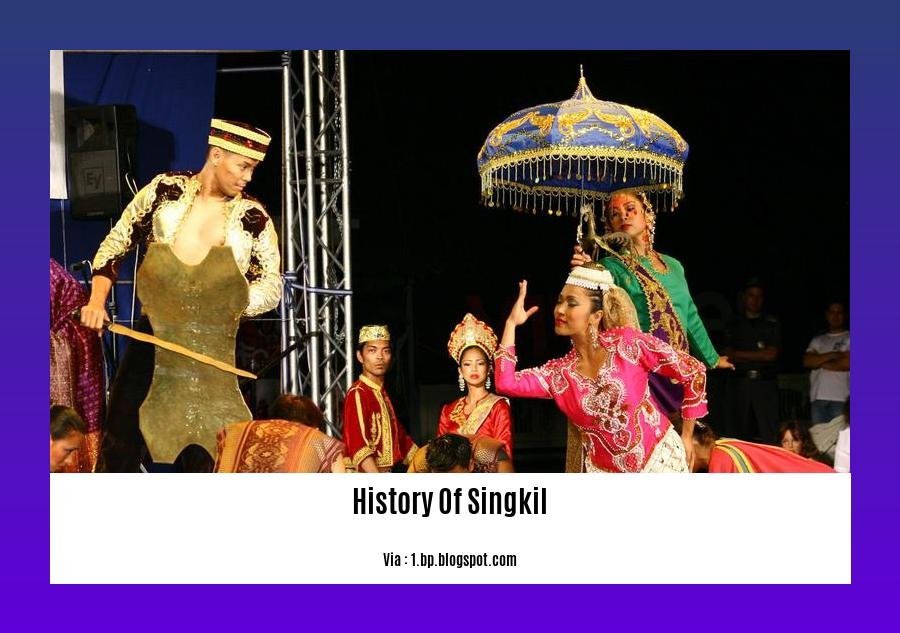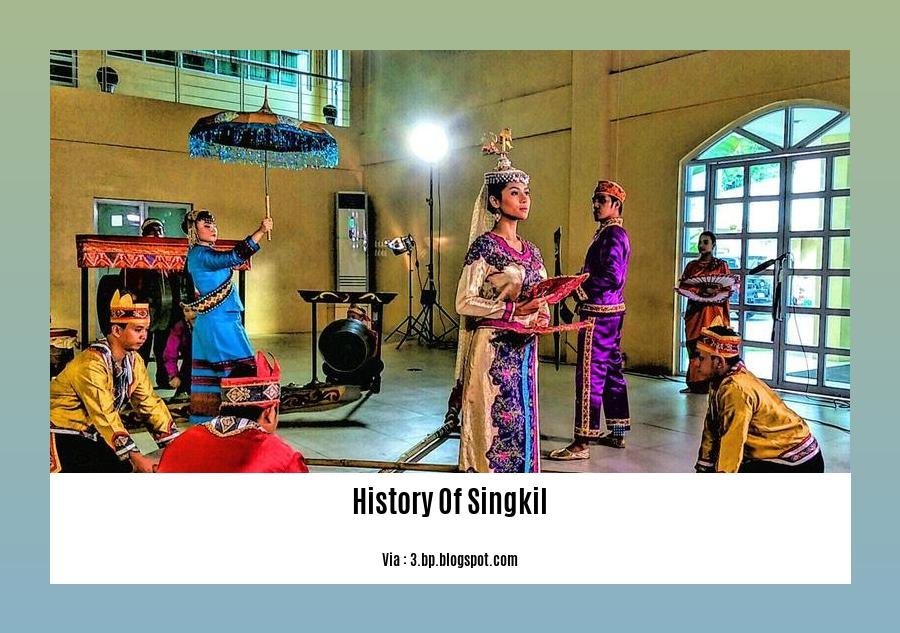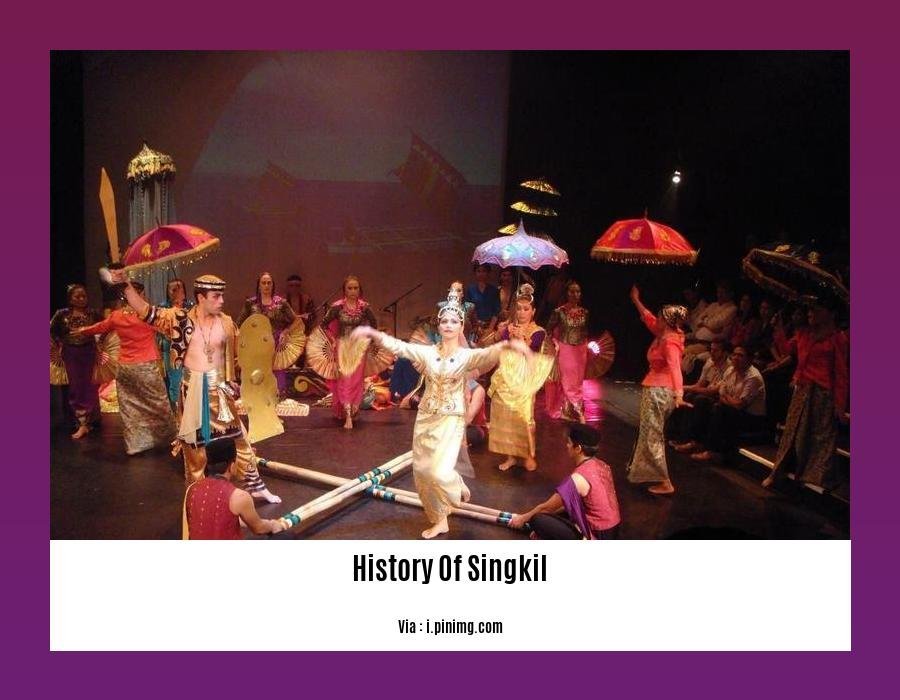Embark on a captivating journey through time as we unveil the rich history of Singkil. Nestled in the heart of Southeast Asia, this vibrant region has played a pivotal role in shaping the cultural heritage of the Nusantara archipelago. From ancient trading routes to the diverse ethnic groups that have called it home, Singkil’s story is one of resilience, adaptation, and remarkable resilience. Join us as we uncover the hidden treasures and forgotten tales that have shaped this extraordinary land, in our article titled: Unveiling the History of Singkil: A Journey Through Time.
Key Takeaways:
Singkil, the royal folk dance of the Philippines, originated from the Maranao people of Lake Lanao, Mindanao.
Originally performed by both prince and princess, it became exclusively performed by women due to cultural restrictions.
The dance gets its name from the Maranao term “singkil,” which means “to entangle the feet.”
According to tradition, it originated from the Darangen, the Maranao interpretation of the ancient Indian epic Ramayana.
The Singkil is accompanied by rhythmic clapping of bamboo poles and music from a kulintang and agung ensemble.
Over time, the dance has undergone reinterpretations, particularly by the Bayanihan folk dance group.
**History of Singkil**

The history of singkil, the majestic royal folk dance from the Maranao people of Lake Lanao, Mindanao, weaves an intricate tapestry of cultural heritage, rituals, and traditions. Let’s delve into its fascinating story:
Singkil: The Enchanting Dance of the Maranaos
Singkil, a captivating dance originating from the Maranao people, is a captivating spectacle performed at festivals and ceremonial rites of passage. The heart of the dance lies in its graceful portrayal of a Maranao prince and princess’s courtship, expressed through intricate weaving movements in and out of crossed bamboo poles. These synchronized footwork and obstacles symbolize the challenges and triumphs of their journey together.
A Shift in Tradition
Initially, both the prince and princess performed the dance. However, cultural restrictions on mixed-gender dancing led to an exclusive performance by women, particularly those of noble lineage. This alteration preserved the dance’s essence while honoring cultural norms.
The Name’s Origin
The term “singkil” stems from the Maranao word “singkil,” which translates to “to entangle the feet with disturbing objects,” aptly describing the intricate footwork and obstacles encountered in the dance.
The Dance’s Epic Roots
According to Maranao tradition, the dance finds its origins in the Darangen, their interpretation of the ancient Indian epic Ramayana. The epic’s tales of love, adventure, and heroism provide a rich backdrop for the dance’s graceful movements and captivating storytelling.
Melodies and Rhythms of Singkil
The enchanting dance is accompanied by the rhythmic clapping of bamboo poles, harmonizing with the melodious tunes of a kulintang and agung ensemble. These instruments create a mesmerizing soundscape that perfectly complements the dance’s graceful movements.
Reinterpretations and Adaptations
Over time, the dance has undergone reinterpretations, notably by the Bayanihan folk dance group. Their rendition incorporated elements from the Darangen epic, particularly episodes involving Prince Bantugan and Princess Gandingan. These adaptations have enriched the dance’s storytelling and cultural significance.
Conclusion
The **history of singkil** is a testament to the Maranao people’s rich cultural heritage, artistry, and storytelling prowess. From its origins in the Darangen to its adaptation by the Bayanihan folk dance group, the dance has evolved while maintaining its captivating essence. Today, singkil stands as a symbol of the Maranao people’s deep cultural roots and their enduring contribution to Philippine dance and cultural heritage.
Learn the history of sewing and explore its evolution from a simple craft to a versatile art form.
Discover the fascinating history of singing bowls; how they came to be, their uses throughout time, and the people that introduced them to the world.
Experience the rich history of Smiths watches and understand their unique identity in the watchmaking industry.
The Influence of the Acehnese Sultanate

In this article, we will dive into the profound impact the Acehnese Sultanate has had on the storied past of Singkil, a region steeped in rich cultural heritage. As we explore the intricate tapestry of history, we’ll uncover the myriad ways in which the sultanate’s presence has left an indelible mark on this captivating corner of Southeast Asia.
Historical Overview: The Rise of the Acehnese Sultanate
The Acehnese Sultanate, founded by Ali Mughayat Syah in 1520, emerged as a formidable power in northern Sumatra, commanding a vast territory that included much of present-day Aceh province. Its strategic location along the Strait of Malacca, a critical trade route connecting the Indian Ocean to the South China Sea, proved pivotal to the sultanate’s rise to prominence.
Expansion and Trade
Under the reign of Alauddin al-Kahar, the Acehnese Sultanate embarked on a period of territorial expansion, conquering neighboring kingdoms and establishing control over key ports and trading hubs. This strategic move allowed the sultanate to tap into the lucrative spice trade, amassing vast wealth and influence.
Cultural and Religious Influence
The Acehnese Sultanate played a pivotal role in spreading Islam throughout the region. It established religious schools and mosques, promoting Islamic teachings and fostering a deep sense of religious identity among its subjects. This cultural and religious influence extended beyond Aceh’s borders, contributing to the Islamization of Southeast Asia.
Conflict and Competition
The sultanate’s quest for dominance brought it into conflict with neighboring kingdoms and European colonial powers. It engaged in fierce battles with the Portuguese, who sought to control the lucrative spice trade, and with the Sultanate of Johor, its rival for supremacy in the region.
Legacy and Enduring Impact
The Acehnese Sultanate, despite facing challenges and eventual decline, left a lasting legacy on Singkil and the broader region. Its influence is still evident in the cultural practices, traditions, and religious beliefs of the local population. The sultanate’s role in promoting trade, spreading Islam, and shaping the political landscape of Southeast Asia continues to be a source of fascination for historians and scholars alike.
Key Takeaways:
- The Acehnese Sultanate was a powerful kingdom that ruled over northern Sumatra from the 16th to the 19th centuries.
- The sultanate’s strategic location along the Strait of Malacca allowed it to control the lucrative spice trade.
- The Acehnese Sultanate played a key role in spreading Islam throughout the region.
- The sultanate engaged in conflicts with neighboring kingdoms and European colonial powers.
- The sultanate’s legacy is still evident in the cultural practices, traditions, and religious beliefs of the local population.
Citations:
Aceh Sultanate – Wikipedia
The Aceh Sultanate and Its Role in the Spread of Islam in Southeast Asia
Singkil in the Colonial Era
Key Takeaways:
Singkil is a traditional dance in the Southern Philippines notable for its dramatic portrayal of the royal courtship, performed by a pair of male and female dancers.
The dance originated from the Tausug people, an ethnic group that migrated from Borneo.
In the colonial era, Singkil was recognized for its uniqueness and exotic allure, frequently performed at royal courts and special gatherings.
During the American occupation, the dance was banned due to its perceived association with pagan rituals, leading to a decline in its practice.
After the country’s independence, Singkil was revived and became an integral part of Philippine folk dance, showcasing the country’s rich cultural heritage.
Today, Singkil is a signature dance performed by cultural troupes and dance enthusiasts, captivating audiences with its intricate steps and graceful movements.
Tracing the History of Singkil
Singkil, an enchanting traditional dance in the southern Philippines, tells a tale of courtship, drama, and cultural resilience. The dance’s origins can be traced to the Tausug people, an ethnic group that crossed from Borneo many centuries ago.
Embracing a vibrant culture rich in storytelling and performance, the Tausugs developed Singkil as a symbolic dance that depicted the courtship between a prince and princess.
In this dance, the prince, holding a sword and shield, and the princess, adorned with fans or handkerchiefs, engage in a captivating interplay of grace, skill, and agility.
A Performance of Grace, Skill, and Symbolism
The charm of Singkil lies in its captivating performance. As the dancers move to the rhythmic beat of traditional instruments, the bamboo poles clack rhythmically, creating a harmonious accompaniment to their graceful steps.
The intricate footwork, twirls, and weaves symbolize the challenges and obstacles that lovers encounter in their journey together.
The dance also incorporates elements of mock combat, highlighting the prince’s prowess and bravery in protecting his beloved.
Singkil’s Resilience Through the Colonial Era
The arrival of the colonial powers brought significant changes and challenges to the practice of Singkil.
During the American colonial period, the dance was prohibited due to its perceived association with pagan rituals, leading to a decline in its performance.
However, the dance’s spirit and significance endured, and after the country’s independence, Singkil was revived and became a celebrated part of Philippine folk dance.
Today, it is performed by cultural troupes, dance enthusiasts, and students, showcasing the country’s rich cultural heritage and the enduring allure of tradition.
Sources:
Singkil – Wikipedia
The Tausug People and Their Culture
Preserving and Celebrating Cultural Heritage
Singkil dance is a pearl of Philippine cultural heritage, a radiant testament to the Maranao people’s artistry. Originating from the shores of Lake Lanao, this captivating dance beautifully portrays the courtship between a prince and princess through intricate movements amidst crisscrossed bamboo poles.
The dance is also a storyteller, deeply rooted in the Maranao epic Darangen. Every step, every twirl, and every clash of bamboo poles narrates a chapter of this epic tale.
Like many cultural treasures, Singkil faced the risk of fading into obscurity. But thanks to the efforts of dedicated individuals and communities, this dance has not only survived but has flourished.
How is Singkil Preserved and Celebrated?
Teaching in Schools: Singkil is taught in schools to ensure its continued existence, ensuring that future generations carry the torch of this cultural legacy.
Dance Troupes: Dance troupes across the Philippines, like the renowned Bayanihan Folk Dance Company, have played a crucial role in preserving and promoting Singkil.
Cultural Festivals: Singkil is a highlight of many cultural festivals, showcasing the richness and diversity of Philippine dance.
–Competitions: Dance competitions provide a platform for young dancers to showcase their talent, fostering friendly rivalry and encouraging the perpetuation of Singkil.
Key Takeaways:
– Singkil is a traditional dance from the Philippines that originated with the Maranao people of Lake Lanao.
– The dance depicts a prince and princess gracefully dancing between crisscrossed bamboo poles.
– Singkil is not only a source of pride and joy but is also taught in schools to ensure its preservation.
– The dance has evolved over time, with reinterpretations and changes introduced by the Bayanihan folk dance group.
References:
[1] Immerse in Singkil: A Vibrant Traditional Dance of the Philippines: https://sinaunangpanahon.com/singkil-traditional-dance-of-the-philippines
[2] Singkil Dance – Philippines: Dance of a Princess inspired from the Epic of Darangen:
FAQ
Q1: What is the origin of the Singkil dance?
A1: The Singkil dance originated from the Maranao people of Lake Lanao in the Philippines, and is deeply rooted in their rich cultural heritage.
Q2: What is the significance of the bamboo poles in the dance?
A2: In the Singkil dance, the bamboo poles are intricately woven together to form obstacles that the dancers must skillfully navigate. This element represents the challenges and obstacles that the Maranao princess had to overcome to find love and happiness.
Q3: Why is the dance performed ausschließlich by women?
A3: Originally performed by both men and women, the Singkil dance gradually evolved into an exclusively female performance due to cultural restrictions on mixed-gender dancing. This shift allowed the dance to preserve its grace and elegance while maintaining its cultural significance.
Q4: What is the connection between Singkil and the Darangen epic?
A4: The Singkil dance draws inspiration from the Darangen, a Maranao interpretation of the ancient Indian epic Ramayana. The dance incorporates elements from the epic, particularly episodes involving Prince Bantugan and Princess Gandingan, adding depth and richness to the performance.
Q5: How has the Singkil dance evolved over time?
A5: While remaining faithful to its traditional roots, the Singkil dance has undergone reinterpretations and changes over the years. Notably, the Bayanihan folk dance group introduced new elements and interpretations, incorporating episodes from the Darangen epic and creating a more dynamic and captivating performance.
- China II Review: Delicious Food & Speedy Service - April 17, 2025
- Understand Virginia’s Flag: History & Debate - April 17, 2025
- Explore Long Island’s Map: Unique Regions & Insights - April 17, 2025



![[Phrase Match] Embracing Evolution: A Journey Through Contemporary Dance History contemporary-dance-history_2](https://www.lolaapp.com/wp-content/uploads/2023/12/contemporary-dance-history_2-150x150.jpg)












